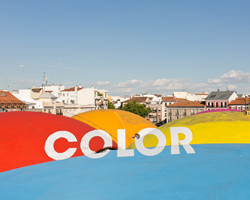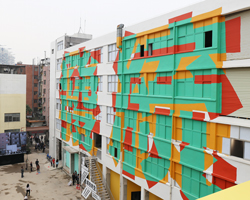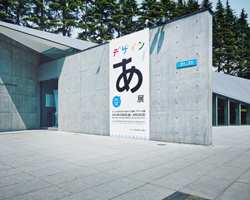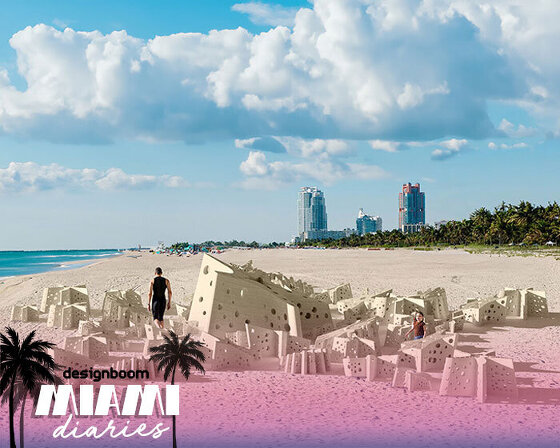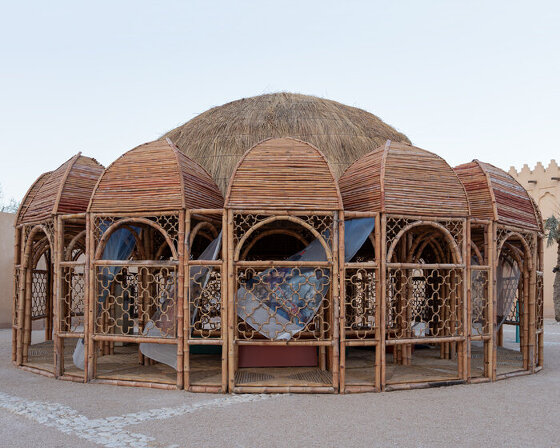boa mistura from left to right: juan jaume, pablo ferreiro, javier serrano, rubén martín, pablo purone
photo by nerea lopez
the term ‘boa mistura’ means ‘good mixture’ in portuguese, making it the perfect name for this diverse group of young designers, artists and architects from madrid who have worked together on numerous art interventions and murals across the world since 2001. designboom spoke to the boa mistura members (juan jaume, pablo ferreiro, javier serrano, rubén martín and pablo purone) to learn more about how they formed and their bid to bring communities together through art and design.
designboom: please could you tell us how boa mistura was formed?
boa mistura: we’ve all known each other since we were around 14 or 15 years old, we met while painting graffiti on the streets of the neighborhood where the five of us grew up – alameda de osuna, which is on the outskirts of madrid. we’ve used the name boa mistura since those days – 2001. over time we’ve become very close friends and collaborators – always working as a team, traveling around spain and the world together.
after we finished our degrees (rubén martín is civil engineer, pablo ferreiro graphic designer, javier serrano architect, juan jaume fine arts and pablo puron publicist and illustrator) we chose not to enter the fields that we’d studied at university. instead we decided to use our new knowledge and take the work we did boa mistura to the next level.
we established boa mistura as a studio in 2010 – we feel very fortunate to earn a living from what we love doing the most.

‘al karama’ (dignity), algiers, algeria, 2013
algiers’ old town, casbah, was declared a world heritage site by the UNESCO in 1992, but nowadays it is very damaged. it is called ‘la blanche’ (the white one), due to the original color in which the mediterranean port was painted years ago. it seemed very poetic to us, the idea of bringing back the white color, but preserving some of the old and wasted color, we decided to write inspiring messages that could make the walls and people shine again

‘al karama’ (dignity), algiers, algeria, 2013
we had to be respectful, so we decided to barely intervene. bring back the white color to the city and freeze time between two layers of paint. sentences and positive words are the sum of the days we lived there and the feeling we got from the muslim society. the intervention respects some parts of the original walls by keeping the inside of the calligraphy with the original color, and painting the rest of the wall with white. some fragments are more understandable than others, some others can barely be guessed, creating this way, a magical effect that somehow demonstrated that these words were always there.
DB: how do you share / divide the workload between members?
BM: right from the start we refused to let our individual egos get in the way of the bigger picture that is boa mistura.
the basis of all our work is constructive discussion. all the projects begin with a fresh brew of four coffees and one tea. we share our ideas, and listen to what each of us thinks and it’s very important that even at the earliest stage all five of us feel we’re on the right path with what we’re proposing.
our different backgrounds and personalities mean that there’s always different points of view on the same project. we put all the ideas on the table and review them together until one idea becomes a clear winner and from that point we start sketching and shaping the project.
in the execution phase, is not necessary for there to be the five of us on site (unless it’s a big project) and regardless of which of us executes the final design or not we all feel responsible for the work, because every project has been conceived together.
we like to think of boa mistura as a monster with five heads, ten arms and one big heart.

color, madrid, spain, 2013
the ‘mercado de la cebada’ is located in the heart of ‘la latina’, the epicenter for ‘tapas’ in madrid. although it is a symbol for the neighbors, it needed renovation. this intervention takes over six domes (4.800 m2) and the two main façades (650 m2).
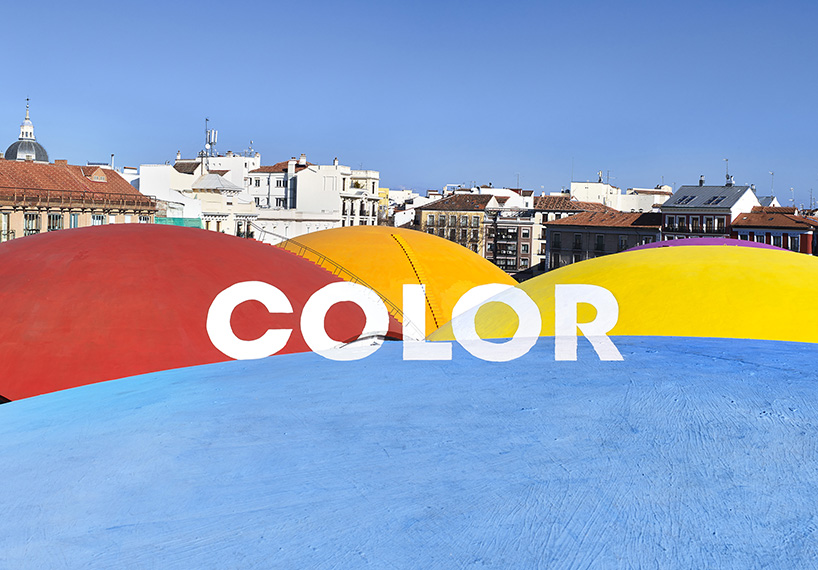
color, madrid, spain, 2013
on the domes, we used the complexity of their shape, to finish the intervention writing with the technique of anamorphosis, the word ‘color’. we changed the color of every dome, modifying this way the landscape of the area. the colors show the optimism and somehow bring out what is happening inside the market.
DB: what do you enjoy most about working on the streets?
BM: the best thing about working on the streets is the direct contact with the people. on the street you create a direct dialog between the artist and the city, without segmentation. your work is for everyone. your work is no longer yours when you get it out there – it’s everybody’s.
for us, cities are living organisms, created by and for living beings. people who work on the streets are agitators, we try to make cities more human. make the cities interact with their inhabitants.
the human factor, that relations between people is what we enjoy the most of working on the streets.

dream, hamar, norway, 2012
hamar is the third largest city in norway. it is located inland, at the shore of the mjøsa lake, the soul of the city. stortorget is the norwegian term used to discuss the main space for relationship, a word we understand as public space or square. in this case, the rise of automobile made stortorget, the city’s main parking lot, losing its original use thought as a space for interaction. the architectural firm ecosistema urbano proposed a collaborative process to redesign the square.

dream, hamar, norway, 2012
our intervention consisted on painting the 1500 m2 floor of the square, getting it back for the citizen. we made a contemporary interpretation of the traditional norwegian patterns, that inspired us to weave a new ‘blanket’.
DB: how has your work evolved in recent years?
BM: when we started, with our work we were only looking at the results aesthetically. gradually, our work has been evolving, we have been adding different layers to make it more complete and enriching.
maybe, the first step of this evolution was to begin to consider the place where we are going to intervene. all of our works are linked to the place – nobody is going to rip our work off the street and move it. we do site specific projects which have to create a dialog with the place, its history and the people living there.
before we start working, we ask ourselves the question; ‘is our work going to improve the place?’ if the answer is ‘no’, then we simply don’t proceed.
gradually the social and participatory dimension of our projects came about, this changed the aim of the work again. at the beginning, we were only was looking to transforming spaces physically, aesthetically. now, we look for a deeper transformation, one that involves the people who will live with our work.
hopefully our process and results will continue to become more and more meaningful with time.
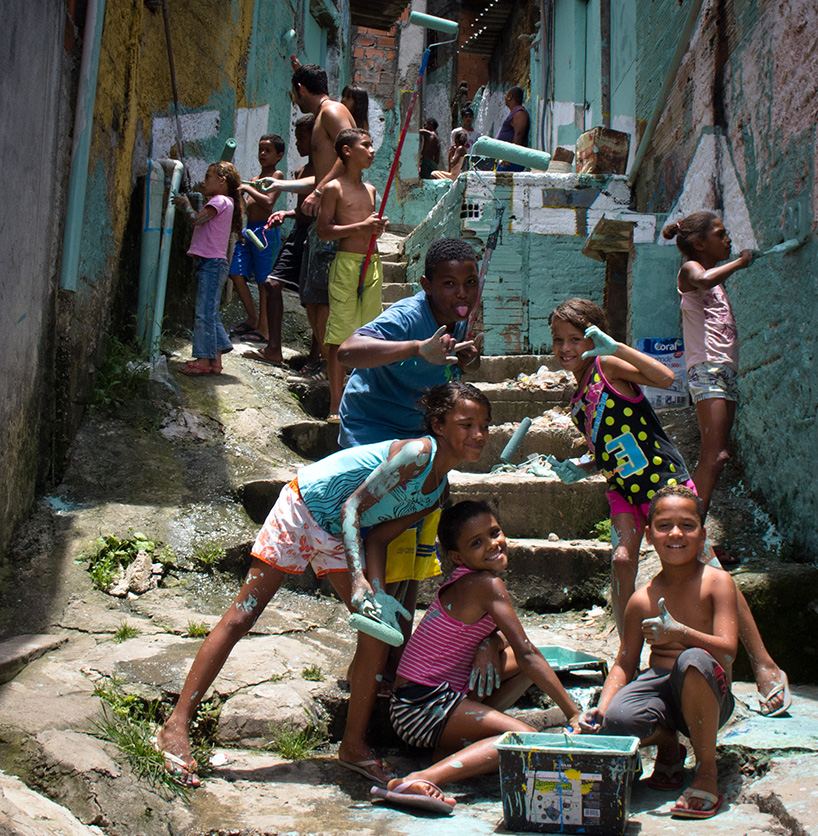
luz nas vielas, sao paulo, brazil, 2011
we had the opportunity to live in a favela with the gonçalves family. during the first few days, we realized of the possible framework made by the narrow and winding passageways that connect the up and low urban areas, known as ‘vielas’.

luz nas vielas, sao paulo, brazil, 2011
the project aims to respond to this characteristic spatial complexity. flattening the perspective from a point (anamorphism), the words ‘beleza’, ‘firmeza”, ‘love’, ‘doçura’ and ‘orgulho’ are read and framed by a flat color, equally covering all the construction materials, democratizing the space. for us, these words are the best portrait of the favela. (see designboom’s article on this project)
DB: which projects have had the biggest impact on the collective?
BM: every project has been another step on our journey, so it’s always hard to identify the most ‘important’ but to name a few we’d probably say ‘diamond inside’ – a project that we developed in cape town in march 2012, going to south africa completely changed our lives.
we were invited by freddy sam, a south african street artist and gallery owner who was starting to run a residency program for artists in the neighborhood of woodstock.
when we landed there, we found a reality completely different that what we were used to; poverty, gangs, prostitution… we didn’t know how to face that social fabric, and we decided to spent the first days just walking around the community, meeting the neighbors and talking with them, playing with the kids, listening to stories about the place… trying our best to fit into the community.
all of the inhabitants talked to us about inspiration and about how a small change can generate bigger changes. you could feel the spirit of mandela inside all of them. one of the locals told us a phrase that blew us away; ‘who knows if the next mandela is one of this kids, and what will have made him to be. maybe your work here could be that spark’.
that sentiment was very moving and in that moment we realized the responsibility we have as artists who works in public spaces, about how our work could be a spark of inspiration for the people who lives together with it.
since then we have always made a concerted effort to fill our works with positivity and optimism and involve the local community directly in the work.
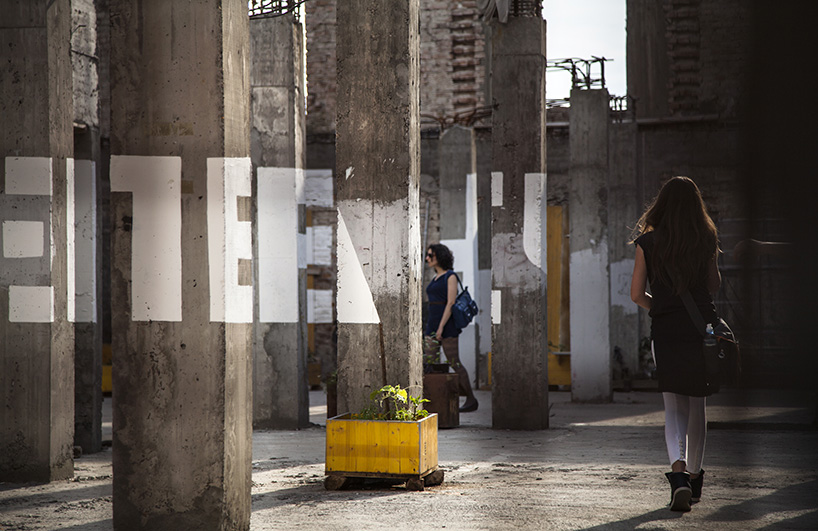
mikser, belgrade, serbia, 2014
from one of the corners of the old spanish house, you can read ‘a kind word’ and from the opposite spot, ‘opens even an iron gate’. a nice serbian proverb we chose to complement this magic space which was abandoned after it was bombed during the WWI.

mikser, belgrade, serbia, 2014

mikser, belgrade, serbia, 2014
DB: what other valuable lessons has your work taught you?
BM: the most important lessons we have learned are human lessons. every time we spend time living in a run-down community, we value more and more things about everyday life. these experiences enrich our souls, and help us grow as human beings, and it is reflected in our work.
one important lesson that we’ve learn through all this years is that sometimes it’s better to ask forgiveness than permission, but our lawyer and some municipalities do not agree with this!
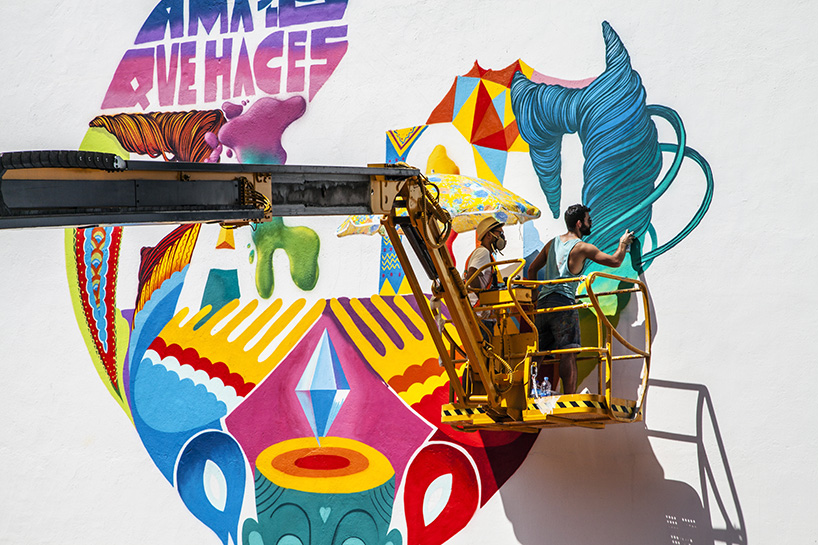
pasión, madrid, spain, 2014
we feel truly passionate for what we do. passion is the engine that helps us face the “day to day” and to work with color in order to make our cities more human. this big heart is presented in salamanca street and invades the exhibition hall of the alcobendas art center.

pasión, madrid, spain, 2014
the heart is composed by tinier elements full of symbolism: a head from which a diamond grows as an allusion to the power of imagination, guarded by two birds that make it fly; a flower that talks about life and the sentence of ‘ama lo que haces’ (love what you do) which is for us very significant. the rest of the composition is composed by shapes and colors that define the word ‘pasión’ (passion).
DB: what would your dream project be?
BM: our ideal project would be one in which all the things we’ve talked about, all the layers we’ve been adding to our work over the years come together on the largest surface possible: a whole neighborhood or an entire city. we want to transform lives and communities foe the better with our work and the more people the work can have a positive effect on the better.

somos luz, el chorrillo, panama, 2013
‘somos luz’ (we are light) is the message we chose to write, with the neighbors help, on the 50 apartments of the begonia i building in the community of el chorrillo in panama. the piece is so big (more than 2000 m2 painted) that we can say it is inhabited and changes with the neighbors’ interaction.

somos luz, el chorrillo, panama, 2013
not only the façade, but the corridors and stairways were painted as well, they are turned now into an abstract color composition that comes to life every time the neighbors hang the wet clothes or just look out from the balcony.
DB: what are some of your current fascinations and how are they influencing your work?
BM: for a while now, we have been fascinated with the written word. we feel that it is the most effective way to communicate. no room for interpretations, a word is simple and direct. it is what it is. if you read a positive word, or a beautiful or inspiring phrase it puts you in a better mood which you then emit to your surroundings.
we have been working for months on the américas project – studying vernacular cultures such as otomíes, aztecs, etc. it has coincided in time with the conception of the artwork for ‘corazón’ the last studio album of carlos santana, for which we also studied the huichol and alebrijes (mexican craft), so now we are very immersed in mexican imaginary; geometries, abstractions, vivid colors and so on.
la colonia de las americas, queretaro, mexico, 2014
a humble community of working class people consisting of housing (much of which is self built) and small business: ‘misceláneas’ (grocery stores), taquerías, and cantinas. américas is located across two sides of a hill, and has a ‘boomerang’ form overlooking the two main highways of the state; the ’5 de febrero’ road and ‘bernardo quintana’, which converge exactly at the apex of las amércias — as a result the neighborhood is seen daily seen by thousands of people.
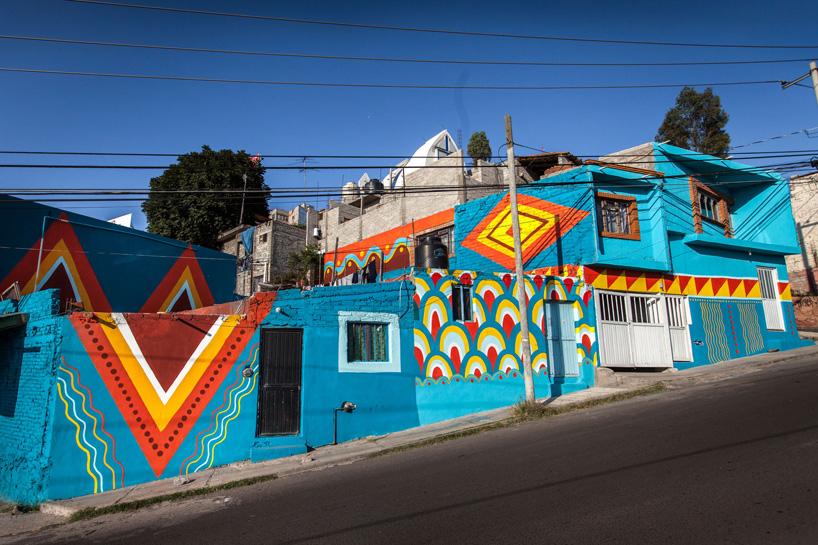
la colonia de las americas, queretaro, mexico, 2014
late last year, boa mistura began work on a largescale intervention that reinforces the concept of ‘identity’ in the neighborhood. the first phase saw volunteers paint over 30 buildings with bright colors and forms inspired by the art of the otomíes, an indigenous people hailing from the same part of mexico. the second phase of the project will begin in september 2014 and and continue intermittently until all 1074 buildings have been re-painted. (see designboom’s article on this project).
DB: what’s your team motto?
BM: ‘love what you do’ – work from the heart and everything will turn out well.
boa mistura (9)
graphic studio interviews (193)
public art (650)
PRODUCT LIBRARY
a diverse digital database that acts as a valuable guide in gaining insight and information about a product directly from the manufacturer, and serves as a rich reference point in developing a project or scheme.


